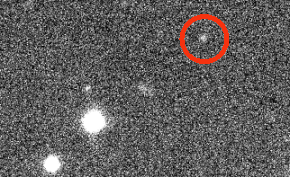Kore (moon)
 Images of Kore from the Canada-France-Hawaii Telescope on 26 February 2003 | |
| Discovery | |
|---|---|
| Discovered by | Scott Sheppard et al. |
| Discovery date | 2003 |
| Designations | |
Designation | Jupiter XLIX |
| Pronunciation | /ˈkɔːriː/[1] |
Named after | Κόρη Korē |
| S/2003 J 14 | |
| Orbital characteristics [2] | |
| 24543000 km | |
| Eccentricity | 0.325 |
| −779.2 days | |
| Inclination | 145.0° |
| Satellite of | Jupiter |
| Group | Pasiphae group |
| Physical characteristics | |
| 2 km | |
| 23.6 | |
Kore /ˈkɔːriː/, also known as Jupiter XLIX, is the outermost natural satellite of Jupiter. It was discovered by a team of astronomers from the University of Hawaii led by Scott S. Sheppard in 2003 and given the provisional designation S/2003 J 14 until its naming in 2007.[3][4][5] It was the 49th moon of Jupiter discovered.[6]
Kore is about 2 kilometers in diameter, and orbits Jupiter at an average distance of 23,239,000 km in 723.720 days, at an inclination of 141° to the ecliptic (139° to Jupiter's equator), in a retrograde direction and with an eccentricity of 0.2462.
It belongs to the Pasiphae group, which is made up of irregular retrograde moons orbiting Jupiter at distances ranging between 22.8 and 24.1 Gm, and with inclinations ranging between 144.5° and 158.3°.
It was named after Kore, another name for the Greek goddess Persephone (from the Greek κόρη, "daughter [of Demeter]").[5]
References
- ^ as 'Core' in Noah Webster (1884) A Practical Dictionary of the English Language
- ^ S.S. Sheppard (2019), Moons of Jupiter, Carnegie Science, on line
- ^ IAUC 8116: Satellites of Jupiter and Saturn Archived 2006-05-05 at the Wayback Machine 2003 April (discovery)
- ^ MPEC 2003-G10: S/2003 J 14 2003 April (discovery and ephemeris)
- ^ a b IAUC 8826: Satellites of Jupiter and Saturn 2007 April (naming the moon)
- ^ James, Andrew. "JUPITER : Part 3". www.southastrodel.com. Retrieved 2023-04-15.